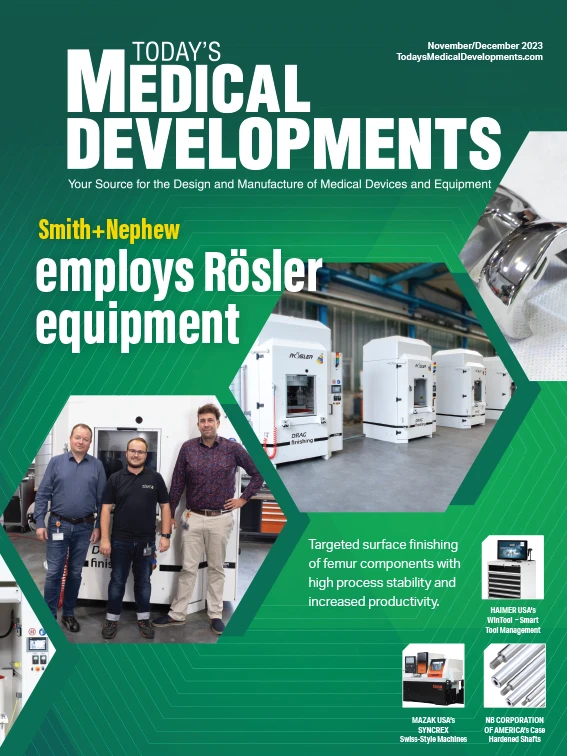
Engineered swelling fluids have found a crucial role in complex medical device design and fabrication companies. These devices, ranging from venous access systems to infusion pumps, rely on hoses and tubes to transport fluids, gasses, and other materials. Multi-lumen tubing has simplified device operation, thanks to its lightweight, flexible nature. However, thin-walled multi-lumen tubes present manufacturing challenges, particularly during assembly. The labor-intensive and time-consuming process of connecting thin or soft tubes to rigid barbed or textured fittings poses difficulties.
Challenge: Tubing attachment
Medical-grade tubing is a preferred material for its biocompatibility, durability, and flexibility. However, joining medical-grade tubing to rigid components poses challenges due to its lack of stretch and high coefficient of friction. Manual insertion can lead to ergonomic issues for assemblers, stress-cracked tubes, and production inefficiencies.

Solution: Engineered swelling fluids
Engineered swelling fluids expedite and simplify the process of connecting tubing to fittings. These fluids temporarily increase tubing size, facilitating easy attachment. Silicone oil, isopropyl alcohol (IPA), and hexane solvents are commonly used swelling fluids. However, engineered swelling fluids offer a better alternative:
• Silicone oil: Although silicone oil is compatible with most medical tubing, its messy nature and potential for migration make it less than ideal for controlled applications. Cleanup and hygiene challenges also arise due to its migration properties.
• IPA: IPA lubrication aids tubing attachment, but slow drying times and collapse risks for thin-wall tubing impede efficient assembly. Its impact on structural rigidity poses challenges.
• Hexane and toluene solvents: Hexane and toluene are effective but aggressive, potentially damaging materials and affecting device elasticity. They can erase ink markings, mar surface coatings, or destroy delicate components. They also pose ventilation and environmental concerns and are classified as a Hazardous Air Pollutant (HAP).
Benefits of engineered swelling fluids

Engineered swelling fluids stand out as a safer and more effective choice. These fluids uniformly expand tubing walls upon immersion, facilitating easy connection. The fluid evaporates quickly, restoring the tubing’s original properties. Unlike other methods, engineered swelling agents don’t create a permanent bond, allowing for easy separation if necessary. Here are some other benefits to engineered swelling fluids:
1. Simplified connection process: Swelling fluids enable smooth tubing attachment, reducing leakage risks and ensuring a secure fit.
2. Improved materials compatibility: Engineered fluids accommodate various tubing materials, simplifying assembly and inventory management. Engineered swelling fluids are compatible with polyethylene, polyimide, neoprene, ethylene propylene diene monomer (EPDM) or molded thermoelastomer tubing.
3. Faster assembly times: Rapid tubing swelling enhances productivity, reducing cycle times.
4. Enhanced worker safety: Engineered fluids minimize force requirements and help mitigate workplace injuries including hand strains and carpal tunnel syndrome.
5. Reduced waste: Engineered swelling fluids help prevent torn tubing and cracked fittings, limiting scrap parts and production waste.
6. Improved validation:Most engineered swelling fluids are hostile to bioburden, making them easier to incorporate into medical device manufacturing processes. Engineered swelling fluids don’t introduce heat, adhesives, or other substances that could compromise the integrity of the tube, fitting, or device. This facilitates qualification and validation efforts and helps ensure compliance with industry standards.
7. Environmentally friendlier solution: Engineered swelling fluids have a lower environmental impact compared to harsh solvents. Most have low Global Warming Potential (GWP) and don’t contribute to ground or air quality issues. By opting for engineered swelling fluids, medical device manufacturers can more easily adhere to strict environmental regulations, reducing their carbon footprint.
How they work
By immersing one end of the tube in the swelling fluid, the tube rapidly and uniformly swells as predicted. The immersion duration dictates expansion, allowing for precise control. For instance, tubes requiring 1% to 2% expansion for assembly can achieve this in less than a minute.
Post-connection, the engineered swelling fluid promptly evaporates without leaving a residue behind, yielding a secure, leak-proof fit over the fixture, irrespective of geometry. The tubing returns to its original size, shape, durometer, compression, and strength.
A perfect fit
In medical device manufacturing, innovation drives efficiency and quality. Engineered swelling fluids offer a significant advantage in creating reliable connections between tubing materials and fittings. With benefits ranging from enhanced productivity to improved sustainability, these fluids pave the way for safer, more efficient, and environmentally conscious medical device assembly. Collaborating with experts in medical lubrication and coating technology is essential for selecting the best fluid for specific applications, ensuring optimal outcomes in this evolving field.
MicroCare LLC
https://www.microcare.com
Get curated news on YOUR industry.
Enter your email to receive our newsletters.
Explore the November December 2023 Issue
Check out more from this issue and find your next story to read.
Latest from Today's Medical Developments
- STUDER looks back on a solid 2024 financial year
- HANNOVER MESSE 2025: Tailwind for industry
- Find out the latest developments in tool path strategies for machining
- Building, maintaining the Navy’s next generation of maritime platforms
- Pioneering battery-free cardiac implants
- KBC Tools & Machinery marks its 60th anniversary, Founder’s Day
- Address the challenges of machining high-temperature aerospace components
- Elevate your manufacturing operations with April’s Manufacturing Lunch + Learn







